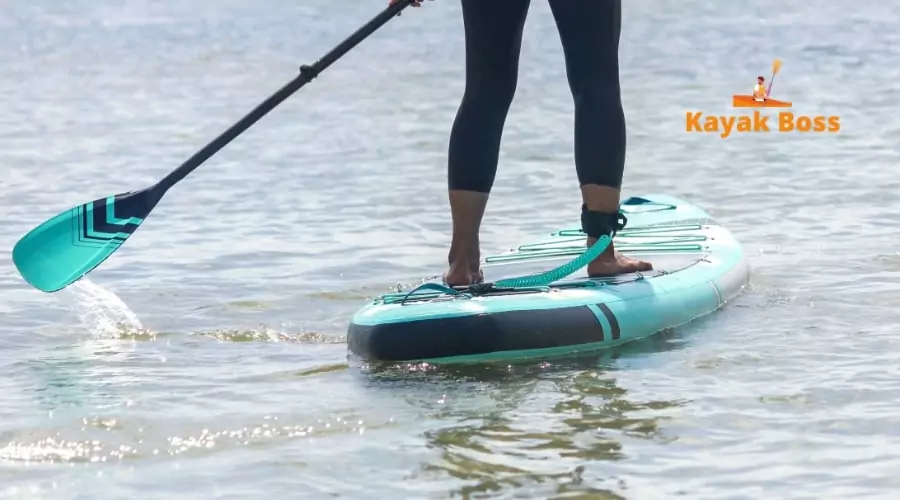Paddleboarding is an increasingly popular water sport that appeals to people of all ages and skill levels. Inflatable paddle boards, in particular, offer many benefits, such as portability, durability, and ease of storage. However, choosing the right size inflatable paddle board can be a daunting task, especially for beginners.

Understanding Inflatable Paddle Board Dimensions
Inflatable paddle boards come in various sizes, and their dimensions are generally described by three key measurements: length, width, and thickness. These measurements affect your paddle board’s stability, speed, and maneuverability, making them essential factors to consider when choosing the right size.
Length
Longer boards offer more speed and glide, making them suitable for long-distance paddling and touring. However, they can be harder to maneuver, particularly for inexperienced paddlers. Shorter boards provide better maneuverability, making them perfect for surfing, whitewater paddling, or those new to the sport.
Width
Wider boards provide more stability, making them ideal for beginners or those with less experience. They also offer a larger surface area for activities like yoga or fishing. However, they may be slower and less responsive than narrower boards, which are preferred by advanced paddlers.
Thickness
Thicker boards offer more volume and, therefore, better buoyancy. This is particularly important for heavier paddlers or those carrying additional gear. Thinner boards, on the other hand, are lighter and more responsive but may not provide enough support for larger users.
Determining Your Ideal Paddle Board Size
To find the perfect inflatable paddle board size for you, consider the following factors:

Your weight and height
Your weight and height are crucial in determining the right paddle board size. As a general rule, a larger and heavier paddler will need a longer and wider board with more volume. Conversely, smaller and lighter paddlers can opt for shorter and narrower boards. Consult the manufacturer’s weight capacity recommendations to ensure your chosen board can support your weight.
Skill level
Beginner paddlers usually benefit from larger, more stable boards, while advanced paddlers might prefer smaller, more agile boards. As you gain experience and improve your skills, you may want to transition to a smaller board for more control and responsiveness.
Intended use
The type of paddleboarding you plan to do also plays a significant role in determining the right size board. For touring or long-distance paddling, a longer board with more glide is ideal. For surfing or whitewater paddling, a shorter, more maneuverable board is recommended. For recreational use, yoga, or fishing, a stable, wider board is preferable.
Popular Inflatable Paddle Board Sizes and Their Uses
Here are some common inflatable paddle board sizes and their recommended uses:
9-10 feet
These short boards are perfect for surfing, whitewater paddling, and kids. They offer excellent maneuverability and responsiveness but may not provide the stability and glide desired for long-distance paddling.
10-12 feet
This versatile size range is suitable for most paddlers and a variety of activities, including recreational paddling, yoga, and fishing. These boards strike a balance between stability and maneuverability, making them an excellent choice for beginners and intermediate paddlers.
12-14 feet
These longboards are designed for touring and long-distance paddling. They offer increased speed and glide, making them perfect for covering greater distances and navigating choppy waters. However, their length may make them more challenging to maneuver, especially for inexperienced paddlers.
14 feet and above
Extra-long boards are typically used for racing or multi-day touring. Their exceptional speed and glide make them suitable for experienced paddlers seeking maximum performance. Keep in mind that these boards can be difficult to handle for those new to the sport.
Additional Factors to Consider
Apart from the dimensions, other factors can influence your choice of an inflatable paddle board:
Board construction and materials
High-quality materials and construction methods are essential for durability, performance, and stability. Look for boards made from military-grade PVC and drop-stitch construction, ensuring a long-lasting and reliable board.
Fins and accessories
The type and configuration of fins can impact the board’s tracking, stability, and maneuverability. Removable fins offer the flexibility to customize your board’s performance based on your needs. Additionally, consider other accessories such as a carry bag, pump, and repair kit, which can enhance your paddleboarding experience.
Budget
Inflatable paddle boards are available at various price points, catering to different budgets. While it’s essential to stay within your means, investing in a high-quality board can save you money in the long run by providing better durability and performance.
Related: Is It Ok to Paddle Board Alone?
Testing and Trying Before You Buy
If possible, try out different sizes and types of inflatable paddle boards before making a purchase. Many paddleboard rental shops or local paddling clubs offer the opportunity to test various boards, allowing you to get a feel for the ideal size and style for your needs. Don’t be afraid to ask for advice from experienced paddlers, instructors, or shop staff, as they can provide valuable insights based on their expertise.
FAQs
Q: How does my weight affect the size of the inflatable paddle board I need?
A: Your weight is the most important factor in determining the size of your inflatable paddle board. The board should be able to support your weight comfortably and safely. A good rule of thumb is to choose a board that can support at least 30 pounds more than your weight. This will ensure that the board is stable and you feel comfortable while paddling.
Q: What is the difference between a beginner and an advanced-level board?
A: If you’re a beginner, a longer and wider board will provide more stability and make it easier to balance. If you’re more experienced, a shorter and narrower board will allow for greater maneuverability and speed. It’s important to choose a board that matches your skill level, so you can enjoy your paddling experience and make the most of your time on the water.
Q: What is the intended use of the inflatable paddle board?
A: The size of the board you need will also depend on how you plan to use it. If you plan to use it for recreational paddling, a wider and longer board will be more comfortable and stable. If you plan to use it for touring or racing, a shorter and narrower board will be faster and more efficient. Make sure to choose a board that meets your specific needs, whether you’re looking for a board for leisurely paddles, exploring new waters, or competing in races.
Q: What size inflatable paddle board is suitable for most recreational paddlers?
A: In general, boards that are 10-12 feet in length and 30-32 inches in width are suitable for most recreational paddlers. If you’re taller or heavier, you may need a larger board. If you’re shorter or lighter, you may be able to use a smaller board. It’s always a good idea to try out a few different sizes and see which one feels the best for you.
Conclusion
Selecting the right size inflatable paddle board is crucial for an enjoyable and safe paddling experience. By considering factors such as your weight, skill level, and intended use, you can determine the perfect board size for your needs. Remember that high-quality materials, fins, and accessories are also essential aspects to consider when choosing a board.
If possible, test out different boards before purchasing to find the perfect fit. With the right size paddle board in hand, you’ll be ready to hit the water and embark on countless adventures, whether it’s for leisure, fitness, or exploration.
